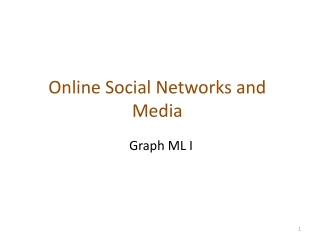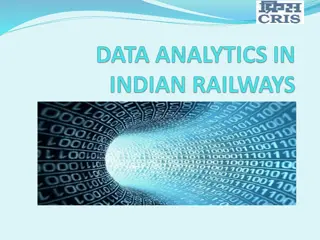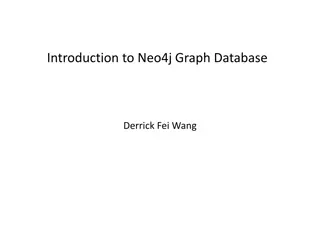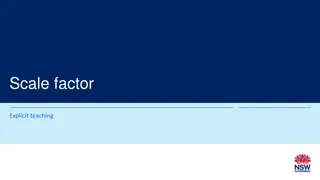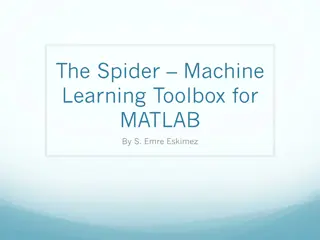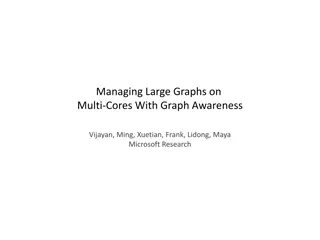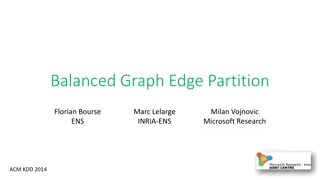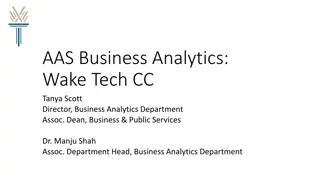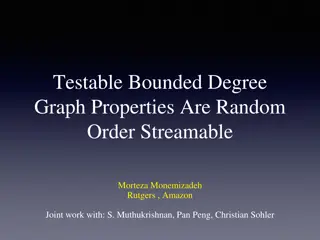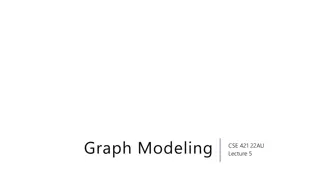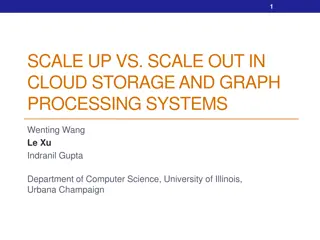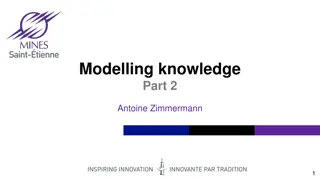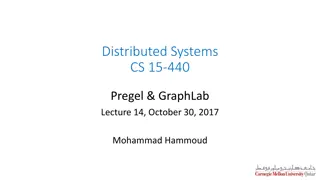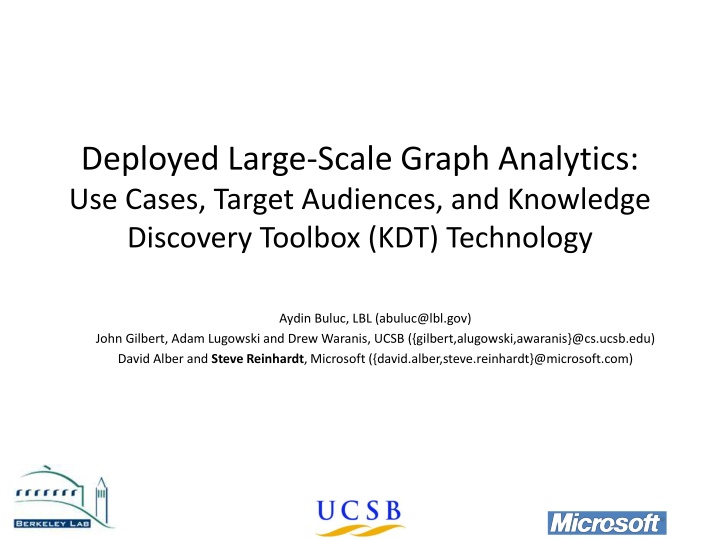
Large-Scale Graph Analytics: Use Cases and Knowledge Discovery Toolbox
Deployed Large-Scale Graph Analytics provides insights into varied applications like social networks, transaction networks, and biological interactions. Explore use cases in homeland security and international banking, enabling experts to analyze graphs quickly and effectively.
Download Presentation

Please find below an Image/Link to download the presentation.
The content on the website is provided AS IS for your information and personal use only. It may not be sold, licensed, or shared on other websites without obtaining consent from the author. If you encounter any issues during the download, it is possible that the publisher has removed the file from their server.
You are allowed to download the files provided on this website for personal or commercial use, subject to the condition that they are used lawfully. All files are the property of their respective owners.
The content on the website is provided AS IS for your information and personal use only. It may not be sold, licensed, or shared on other websites without obtaining consent from the author.
E N D
Presentation Transcript
Deployed Large-Scale Graph Analytics: Use Cases, Target Audiences, and Knowledge Discovery Toolbox (KDT) Technology Aydin Buluc, LBL (abuluc@lbl.gov) John Gilbert, Adam Lugowski and Drew Waranis, UCSB ({gilbert,alugowski,awaranis}@cs.ucsb.edu) David Alber and Steve Reinhardt, Microsoft ({david.alber,steve.reinhardt}@microsoft.com)
Knowledge Discovery Toolbox enables rapid algorithm development and fast execution for large-scale complex graph analytics
Knowledge Discovery Workflow 1a. Cull relevant historical data 2. Build input graph 3. Analyze input graph 4. Visualize result graph 1b. Use streaming data memory Data filtering technologies Graph viz engine KDT
Agenda Use cases and audiences for graph analytics Technology Next steps
Graph Analytics Graphs arise from Social networks (human or animal) Transaction networks (e.g., Internet, banking) Molecular biological interactions (e.g., protein-protein interactions) Many queries are Ranking Clustering Matching / Aligning Graphs are not all the same Directed simple graphs, hypergraphs, bipartite graphs, with or without attributes on edges or vertices,
Use Case: Find Influential People in a Social Network Warfighter wants to understand a social network (e.g., village, terrorist group); see DARPA GUARDDOG Specifically, wants to identify leaders / influencers GUI selects data, calls KDT to identify top N influencers Warfighters
Use Cases Homeland security / Understand roles of members of terrorist groups based on known links between them / Looking just at cell-phone communications, who are the leaders? International banking / Detect money laundering / Find instances of money being transferred at least 5 times and coming back to its source. Common thread: Enabling the knowledge-discovery domain expert to analyze graphs directly gets to the right answer faster and possibly at all. (In the embedded context, the end- user and the KD domain expert are likely different people.)
Audiences End-users / warfighters True end-user GUI not addressed by KDT Knowledge discovery domain experts Are experts in something other than graph analytics Have large graphs they need to explore as part of their work Want simple, robust, scalable, flexible package Graph-analytic researchers Are experts in graph analytics, machine learning, etc. Want to experiment with new algorithms And get feedback from users on efficacy on large data Efficiency-level developers Call-backs in C++ currently have big performance advantage Formatting data for ingest
Agenda Use cases and audiences for graph analytics Technology Next steps
Local v. Global Metrics Degree Centrality v. Betweenness Centrality B A Is vertex A or B most central? A has directed edges to more vertices (degree centrality) B is on more shortest paths between vertex pairs (betweenness centrality)
Algorithms: Insight v Graph Traversals K-betweenness centrality Graph traversals (~= execution time) Exact betweenness centrality O(|E|2) Approximate betweenness centrality Search for better algorithms Egocentrality O(|E|) Degree centrality Insight
Knowledge Discovery Toolbox (KDT) Overview Target audiences Primarily, (non-graph-expert) domain experts needing to analyze large graphs Secondarily, graph-algorithm researchers and developers needing access to highly performant scalable graph infrastructure Target use cases Broadly, problems needing the detail of algorithms that traverse the graph extensively Social-network-based ranking and search Homeland security Current KDT practicalities Abstractions are (semantic) directed graph and sparse and dense vectors, all of which are distributed across a cluster Python interface layered on Combinatorial BLAS Delivers full scaling of CombBLAS with negligible Python overhead for non-semantic graphs v0.2 release expected in October x86-64 clusters running Windows or Linux Open-source code available at kdt.sourceforge.net under New BSD license
Parsimony with New Concepts for Domain Experts Input Graph # bigG contains the input graph comp = bigG.connComp() giantComp = comp.hist().argmax() G = bigG.subgraph(comp==giantComp) (Semantic) directed graphs constructors, I/O basic graph metrics (e.g., degree()) vectors Clustering: Markov, and components Ranking: betweenness centrality, PageRank Matching: k-cycles Markov Clustering Graph of Clusters clus = G.cluster( Markov ) Largest Component clusNedge = G.nedge(clus) smallG = G.contract(clus) # visualize [ ] L = G.toSpParMat() d = L.sum(kdt.SpParMat.Column) L = -L L.setDiag(d) M = kdt.SpParMat.eye(G.nvert()) mu*L pos = kdt.ParVec.rand(G.nvert()) for i in range(nsteps): pos = M.SpMV(pos) Hypergraphs and sparse matrices Graph primitives (e.g., bfsTree()) SpMV / SpGEMM on semirings
Graph API (v0.2) Applications Community Detection Network Vulnerability Analysis Graph500 Graph-problems Ranking Clustering Markov, connected components Matching <None> exact and approx BC, PageRank Algorithms and primitives DiGraph bfsTree, isBfsTree plus utility (e.g., DiGraph,nvert, toParVec,degree,load,UFget,+,*, sum,subgraph,reverseEdges) 64-bit and single-bit elements HyGraph bfsTree, isBfsTree plus utility (e.g., HyGraph,nvert, toParVec,degree, load,UFget) (Sp)Vec (e.g., +,*,|,&,>,==,[], abs,max,sum,range, norm, hist,randPerm, scale, topK) SpMat (e.g., +,*, SpMV, SpGEMM, SpMV_SemiRing, semantic support (filters, objects) Separation of interfaces SpMV_SemiRing SpMM_SemiRing CombBLAS
Semantic Graph Use Case Looking just at cell-phone communications, who are the leaders? import kdt # user function that converts a (file) record into an edge def readRecord(self, sourceV, destV, record): sourceV = record[0] destV = record[1] self.category = record[2] self.type = record[3] return (sourceVert, destVert, self) G = kdt.DiGraph.load( /file/my/graph/data , readRecord) # edges for which the edge-filter returns True will # be used in the calculation edgeFilter = lambda x: x.category == CellPhone G.addEFilter(edgeFilter) # calculate leaders via approximate betweenness centrality bc = G.centrality( approxBC ) leaders = bc.topK(10) Caveat: Currently, expressing the filter in Python (rather than C++) leads to a big performance decrease; reducing/eliminating this decrease is work in progress.
Example Algorithm: Find a breadth-first tree starting from a given vertex 17 4 9 1 8 16 3 Cell-phone call 2 15 Text message 7 14 6 5 from 13 1 17 12 1 11 10 to 17 AT
17 4 9 1 8 16 3 2 15 7 14 6 5 from 13 1 17 12 1 1 11 10 1 1 to 17 AT ATX X
17 4 9 1 8 16 3 2 15 7 14 6 5 from 13 1 17 12 1 11 2 4 10 2 2 42 to 17 AT ATX X
17 4 9 1 8 16 3 2 15 7 14 6 5 from 13 1 17 12 1 11 10 5 6 98 to 5 6 8 9 17 AT ATX X
17 4 9 1 8 16 3 2 15 7 14 6 5 from 13 1 17 12 1 11 10 to 10 11 15 16 17 AT ATX X
The Case for Sparse Matrices The case for sparse matrices Many irregular applications contain coarse-grained parallelism that can be exploited by abstractions at the proper level. Traditional graph computations Graphs in the language of linear algebra Data driven, Fixed communication patterns unpredictable communication. Irregular and unstructured, poor locality of reference Operations on matrix blocks exploit memory hierarchy Fine grained data accesses, dominated by latency Coarse grained parallelism, bandwidth limited
Performance Graph500 in KDT or Combinatorial BLAS 7 6 5 GTEPS 4 KDT 3 CombBLAS 2 1 0 1225 2500 5041 Number of cores Graph500 benchmark on 8B edges, C++ or KDT calling CombBLAS NERSC Hopper machine (Cray XE6) [Bulu & Madduri]: New hybrid of CombBLAS MPI + OpenMP gets 25 GTEPS on 2T edges (scale 37) on 43,200 cores of Hopper
Performance Betweenness Centrality With a few hundred cores, can do even a complex graph analysis in near-interactive time 2M edges, approximate betweenness centrality sampling at 3% Time (secs) MTEPS 600 140 120 500 100 Mega TEPS 400 Seconds 80 300 60 200 40 100 20 0 0 1 4 9 16 36 64 121 256 Cores
Productivity Betweenness centrality Python version initially written to SciPy interfaces Porting to KDT took 11 hours for working, scalable implementation Markov clustering Written by an undergraduate in 6 hours
Agenda Use cases and audience Technology Next steps
Next Steps Core technology Evolve semantic graph support so fully usable Implement support for streaming graphs Engineering Couple with GUI / graph viz package Port to Windows Azure Accept more data formats Extend coverage of clustering, ranking, and matching algorithms
KDT Summary Open-source toolbox targeted at domain experts Scalable to 10B-edge graphs and thousands of cores Limited set of methods, no graph viz yet kdt.sourceforge.net for details If you - have other use cases - need specific data formats or methods - have developed a method please contact me at
Knowledge Discovery Toolbox enables rapid algorithm development and fast execution for large-scale complex graph analytics
Further Info Linked, by Albert-Laszlo Barabasi Graph Algorithms in the Language of Linear Algebra, by John Gilbert and Jeremy Kepner, SIAM
Cloud Benefits for Graph Analytics For domain expert Elasticity of compute resource Ready availability of needed data what? Ready availability of new methods which? For graph-algorithm researcher Quickly try your algorithm on big data Quickly make it visible to domain experts Elastic compute and memory Needed methods Needed big data Data filtering KDT viz
Transport of the mails, transport of the human voice, transport of flickering pictures - - in this century, as in others, our highest accomplishments still have the single aim of bringing men together. Antoine de Saint-Exupery
Undelivered Possibilities Graph viz More ranking/clustering/matching options Availability in Azure Initial stages on disk, later stages in memory Dynamic/streaming graphs
Use Case: Find Influential People in a Social Network Promoter has a SN group Wants to identify influencers on which to focus marketing efforts so as to maximize viral effect of the group Calls KDT with group name, gets back top N influencers Useful for (e.g.) viral marketing, public health Promoter MyGroup
Comparison to Other Parallel Packages Package Target users Interface Supported memory* Graph-alg devs Domain experts Pegasus X Hadoop Distributed on-disk Pregel X C++ Distributed on-disk PBGL X C++ Distributed in-memory MTGL X C++ Shared SNAP (GA Tech) X C Shared SNAP (Stanford) X X C++ / NodeXL Shared GraphLab X C++ Shared CombBLAS X C++ Shared or distributed, in-memory KDT X X Python Shared or distributed, in-memory * Shared meaning either cache-coherent or Cray XMT-style
2 Example Implementation: bfsTree 1 4 5 7 from 1 7 1 6 3 to 7 AT
Technically 2 Ecologically 1 4 5 7 from 1 7 1 6 3 1 1 to 1 7 AT ATX X
Technically 2 Ecologically 1 4 5 7 from 1 7 1 6 3 2 4 to 4 2 4 7 AT ATX X
Technically 2 Ecologically 1 4 5 7 from 1 7 1 6 3 3 to 5 5 7 7 AT ATX X
Technically 2 Ecologically 1 4 5 7 from 1 7 1 6 3 to 6 7 AT ATX X
Many Graphs Dont Decompose Simply onto Distributed Memory 4n exchanges n^2 FLOPS Good locality ? exchanges ? OPS Usually poor locality, hence frequent comms, hence often a poor match for MapReduce 4n exchanges n^2 FLOPS Good locality
Identification of Primitives Sparse array-based primitives Sparse matrix-dense vector multiplication Sparse matrix-matrix multiplication (SpGEMM) Element-wise operations Sparse matrix indexing .* Matrices on various semirings: (x, +) , (and, or) , (+, min) ,
bfsTree Implementation in KDT, for DiGraphs (Kernel 2 of Graph500) Technically Ecologically def bfsTree(self, root, sym=False): if not sym: self.T() # synonym for reverseEdges parents = dg.ParVec(self.nvert(), -1) fringe = dg.SpParVec(self.nvert()) parents[root] = root fringe[root] = root while fringe.nnn() > 0: fringe.spRange() self._spm.SpMV_SelMax_inplace(fringe._spv) pcb.EWiseMult_inplacefirst(fringe._spv, parents._dpv, True, -1) parents[fringe] = fringe if not sym: self.T() return parents SpMV and EWiseMult are CombBLAS ops that do not yet have good graph abstractions pathsHop is an attempt for one flavor of SpMV
pageRank Implementation in KDT (p. 1 of 2) def pageRank(self, epsilon = 0.1, dampingFactor = 0.85): # We don't want to modify the user's graph. G = self.copy() nvert = G.nvert() Technically Ecologically This portion looks more like graph operations G._spm.removeSelfLoops() # Handle sink nodes (nodes with no outgoing edges) by # connecting them to all other nodes. degout = G.degree(gr.Out) nonSinkNodes = degout.findInds() nSinkNodes = nvert - len(nonSinkNodes) iInd = ParVec(nSinkNodes*(nvert)) jInd = ParVec(nSinkNodes*(nvert)) wInd = ParVec(nSinkNodes*(nvert), 1) sinkSuppInd = 0 for ind in range(nvert): if degout[ind] == 0: # Connect to all nodes. for sInd in range(nvert): iInd[sinkSuppInd] = sInd jInd[sinkSuppInd] = ind sinkSuppInd = sinkSuppInd + 1 sinkMat = pcb.pySpParMat(nvert, nvert, iInd._dpv, jInd._dpv, sinkG = DiGraph() sinkG._spm = sinkMat wInd._dpv)
pageRank Implementation in KDT (p. 2 of 2) (main loop) Technically Ecologically G.normalizeEdgeWeights() sinkG.normalizeEdgeWeights() # PageRank loop delta = 1 dv1 = ParVec(nvert, 1./nvert) v1 = dv1.toSpParVec() prevV = SpParVec(nvert) dampingVec = SpParVec.ones(nvert) * while delta > epsilon: prevV = v1.copy() v2 = G._spm.SpMV_PlusTimes(v1._spv) + \ sinkG._spm.SpMV_PlusTimes(v1._spv) v1._spv = v2 v1 = v1*dampingFactor + dampingVec delta = (v1 - prevV)._spv.Reduce(pcb.plus(), pcb.abs()) return v1 This portion looks much more like matrix algebra ((1 - dampingFactor)/nvert)
Graph500 Implementation in KDT (p. 1 of 2) scale = 15 nstarts = 640 Technically GRAPH500 = 1 if GRAPH500 == 1: G = dg.DiGraph() K1elapsed = G.genGraph500Edges(scale) Ecologically if nstarts > G.nvert(): nstarts = G.nvert() deg3verts = (G.degree() > 2).findInds() deg3verts.randPerm() starts = deg3verts[dg.ParVec.range(nstarts)] G.toBool() K2elapsed = 1e-12 K2edges = 0 for start in starts: start = int(start) if start==0: #HACK: avoid root==0 bugs for now continue before = time.time() parents = G.bfsTree(start, sym=True) K2elapsed += time.time() - before if not k2Validate(G, start, parents): print "Invalid BFS tree generated by bfsTree" print G, parents break [origI, origJ, ign] = G.toParVec() K2edges += len((parents[origI] != -1).find())
Graph500 Implementation in KDT (p. 2 of 2) def k2Validate(G, start, parents): ret = True bfsRet = G.isBfsTree(start, parents) if type(ret) != tuple: if dg.master(): print "isBfsTree detected failure of Graph500 test %d" % abs(ret) return False (valid, levels) = bfsRet Technically - #1 and #2: implemented in isBfsTree Ecologically # Spec test #3: [origI, origJ, ign] = G.toParVec() li = levels[origI] lj = levels[origJ] if not ((abs(li-lj) <= 1) | ((li==-1) & (lj==-1))).all(): if dg.master(): print "At least one graph edge has endpoints whose levels differ by more than one and is in the BFS tree" print li, lj ret = False - #3: every input edge has vertices whose levels differ by no more than 1. Note: don't actually have input edges, will use the edges in the resulting graph as a proxy - #4: the BFS tree spans a connected component's vertices (== all edges either have both endpoints in the tree or not in the tree, or source is not in tree and destination is the root) # Spec test #4: neither_in = (li == -1) & (lj == -1) both_in = (li > -1) & (lj > -1) out2root = (li == -1) & (origJ == start) if not (neither_in | both_in | out2root).all(): if dg.master(): print "The tree does not span the connected component exactly, root=%d" % start ret = False - #5: a vertex and its parent are joined by an edge of the original graph # Spec test #5: respects = abs(li-lj) <= 1 if not (neither_in | respects).all(): if dg.master(): print "At least one vertex and its parent are not joined by an original edge" ret = False return ret

